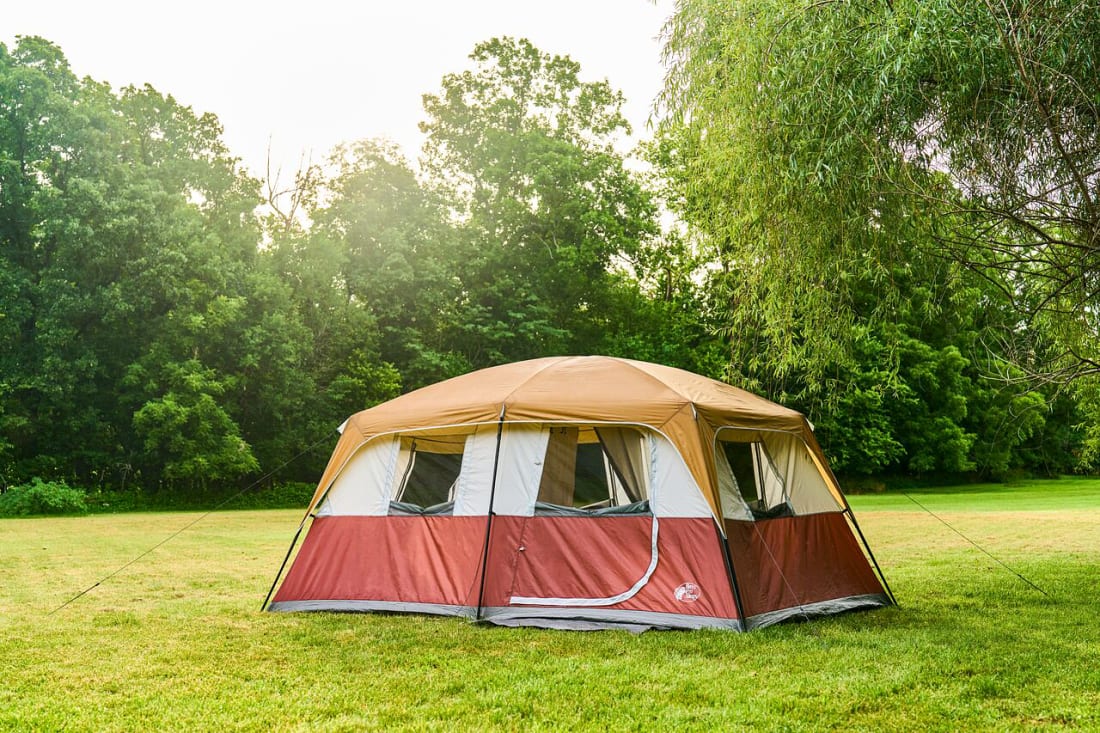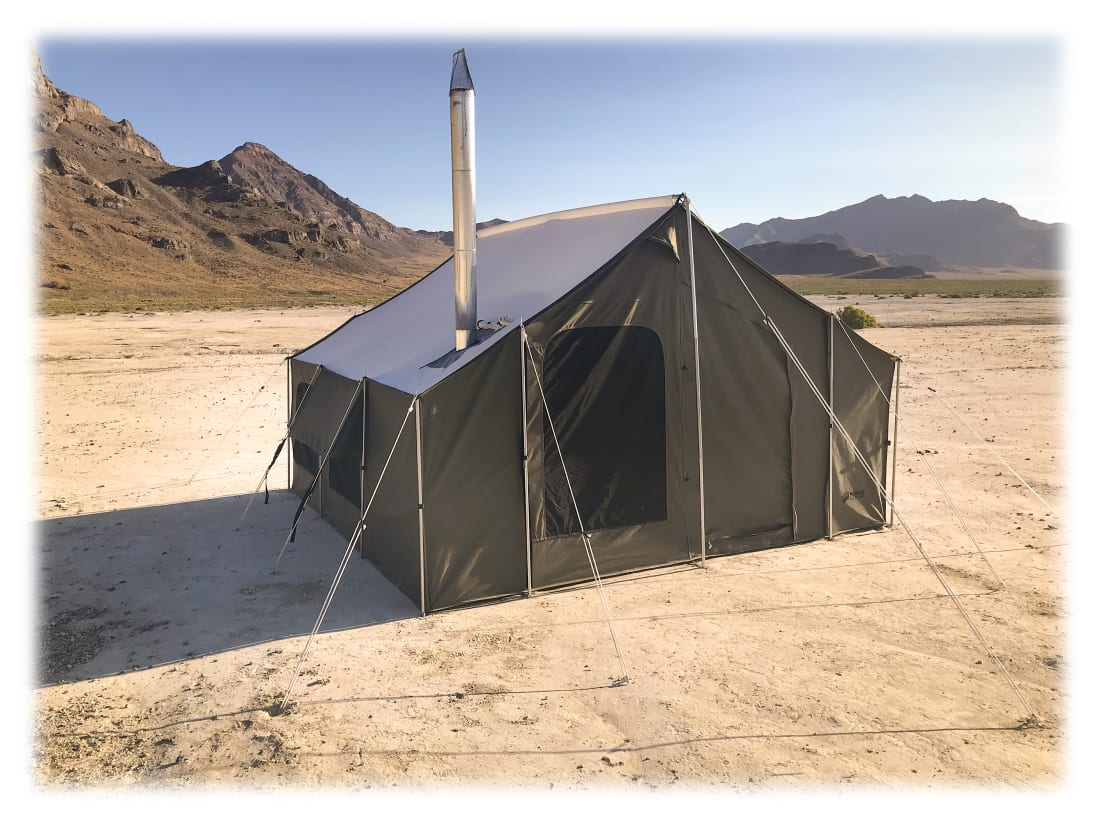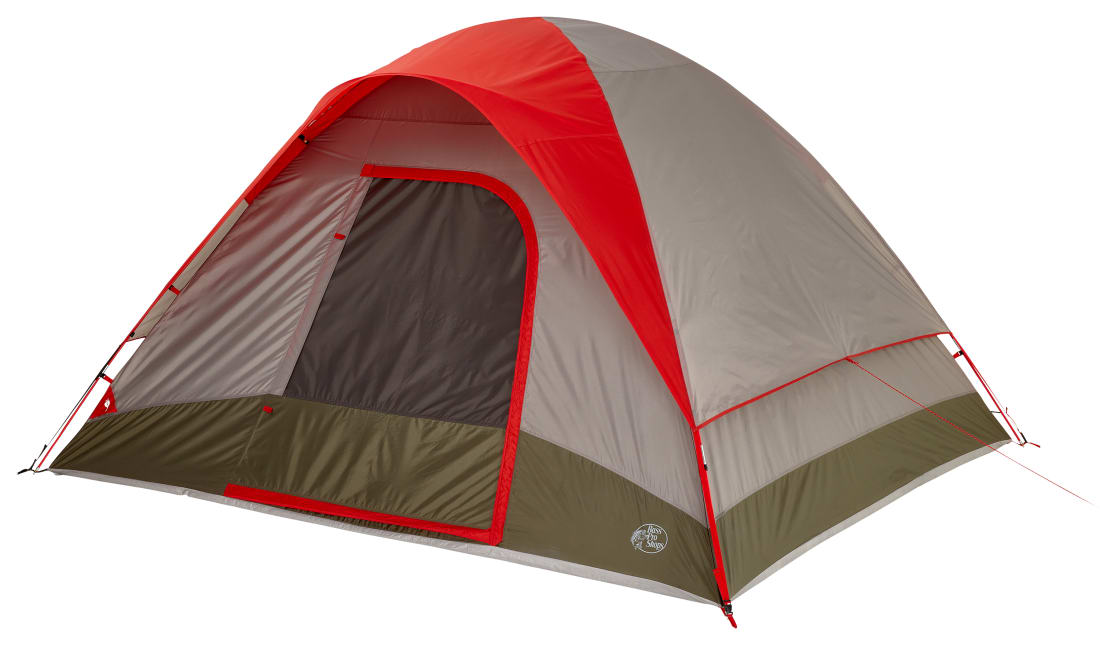
No matter if you're staying at your favorite campground or deep in the backcountry, your tent is your home away from home. And the right tent can make your stay more enjoyable. Whether this is your first tent or you're looking to upgrade, there are a few things to consider when choosing which tent to buy. Let's take a look at some things to consider.
 First, decide what kind of camping you’ll be doing. Will you be camping on the trail? Are you camping with friends and family, or staying in the backcountry for a while? Or are you headed up the mountain? This will affect what kind of tent you’ll get.
First, decide what kind of camping you’ll be doing. Will you be camping on the trail? Are you camping with friends and family, or staying in the backcountry for a while? Or are you headed up the mountain? This will affect what kind of tent you’ll get.
Tip: Buying a tent? Just ask the right questions. Learn how to make sure you find exactly the tent you need for years of fun with your family and friends.
Types of Tents Used for Outdoor & Camping Adventures
Backpacking Tents - The Light Weight Shelter

These minimalist tents prioritize portability, making them lightweight and easy to fit in a pack. Ultralight tents are even lighter, and some models allow you to use your hiking poles to pitch the tent. Since these tents are both 1 or 2 man size, there isn’t much elbow room.
Tip: The Ascend Orion 2-Person Backpacking Tent is easy to carry, easy to setup and gives light packing hikers 3-season protection for the trail. this lightweight tent offers great ventilation, gear storage and protection from ground-level moisture. Carry Weight: 5 lbs. 9 oz. About $119.99

Family or Cabin Tents - For Comfort and Space
Accommodate a larger number of people with plenty of space for gear and family-friendly features are integrated. This design is great for families of all sizes as well as large groups of friends. They’re well-suited for car camping, but not a good choice for extreme conditions.
Tip: 6 Crazy Delicious Hot Dog Recipes Camping Kids LOVE

Tip: The Bass Pro Shops 10-Person Cabin Tent is an easy to setup design, thanks to a strong fiberglass and steel pole frame, the 10-Person Cabin tent goes up in just minutes so you can get to enjoying your weekend faster. Have some separation and us the built-in room divider. You've got room to move in the 14' x 10' with a 7' center height plus an interior gear loft, and hanging storage pockets. About $249.99
Tip: A 12-person tent worth mentioning is the Core Equipment 12-Person 3-Room tent. This tent gives you the room to handle big groups on long extended camping trips. The body features 68 denier polyester mesh. The Core Equipment tent has 2 doors, with a hinged door design on the front. This Cabin-style, 3 room tent has a center height: 80''. Carry weight: 48.58 lbs.

Cold Weather Mountaineering or Expedition Tents for Nature's Most Extreme Conditions
These 4-season tents withstand harsh conditions, such as high winds, snow and cold, so they’re ideal for camping at high altitudes and during the winter. However, they’ll most likely be too warm in warmer weather and condensation will build up inside.
Tip: The Kodiak Canvas 8-Person Cabin Lodge Tent is sturdy enough to take on extreme weather conditions.
Engineered for serious outdoor comfort, the Kodiak Canvas® 8-Person Cabin Lodge Tent delivers rugged protection and refined design for larger groups. Its vertical wall construction and towering 7.5' ceiling create a spacious interior that’s easy to move around in—no crouching required. A large, D-shaped front door offers simple entry and exit, even when geared up.
Six oversized windows feature no-see-um mesh for ventilated views and bug-free airflow, while a covered storm window and roof vents help maintain circulation—even in rain. The tent’s legendary Hydra-Shield™ 100% cotton duck canvas shell blocks water while breathing naturally to prevent mugginess and condensation. A tough 13.5 oz. reinforced vinyl floor with welded seams keeps ground moisture out, no matter the weather.
A stout 1" galvanized steel frame ensures stability in wind and snow, and the integrated 5" stove jack with weather flap supports safe use of a wood-burning stove (not included).
Includes 12" heavy-duty steel rod stakes, YKK® zippers throughout, and a rugged zippered storage bag.
Footprint: 12'L x 12'W x 7.5'H | Weight: 97 lbs.
Lodge and Outfitter Tents - Rugged, Spacious, Wilderness Refuge
These tents serve as base camps, hunting camps or summer camps for extended stays in the backcountry, which makes them an excellent choice for hunting or fishing trips or even family getaways. Outfitter tents also know as "wall tents" provide more headroom than traditional camping tents. They are made for long-term outings and are equipped for cold weather using tent stoves. However, their size also makes them heavier.

Lodge tents combine the structure of a Dome tent with the near-vertical walls of a Cabin tent.
Tip: How to Build Your Own Rocket Stove (video)
Tip: the Cabela's Outback Lodge 8-Person Tent is an easy-to-setup, single wall tent offering storm-ready protection. The Outback features a convenient zippered power port and 3 storage pockets for gear and includes steel stakes, guy lines, fabric sticker, and bottle of seam sealer. Dimensions: 12'L x 12'W x 9'H. Carry Weight: 28 lbs. About $399.99
How Tent Size and Weight Play Into Your Buying Decision
Tent Size Matters
Tents are sized by person capacity (i.e., two-person tent, six-person tent). There is no industry standard for determining capacity, but manufacturers typically allow 20 to 25 sq. ft. per person. This means you’ll most likely be lying right next to your tent mates with your sleeping bags touching or even overlapping. If you want more room, upsize “one person”. Also, look at the floor plan. Some models only allow room for campers, while others have nooks and crannies for storing gear and clothes.
Also Read: More Tent Buying Tips
The Tent's Weight Matters
If you are car camping or have additional help hauling your tent such as an ATV, horse, or eager friends and family, weight is not a large factor. However, if you are carrying it on your back with a week’s worth of gear, every ounce counts, so look for a lightweight tent.
Also Read: Which is Right for You: Air Mattress, Sleeping Bag or Cot?
The Tent's Shape Matters Too
Tent shape makes a huge impact on square footage and overall space. The interior volume of a tent is gauged by floor dimension, floor area and peak height (only at the top point, not consistent throughout). In addition, the more vertical the walls, the more livable space you'll get.
A-Framed Tents
The original A-frame tents, based on pup tents, were lightweight, simple to set up and fairly inexpensive. They had rectangular floors with sloping sides and ridgepoles. However, they had low headroom and little elbow room due to the sloping sides. The modified A-frame improved upon the original by adding a center hoop pole or diagonal center poles. This causes the sidewalls to curve outward, increasing space. Lateral stability also increases to help the tent hold up better in the wind

Backpacking A-frame Tent
Tip: The Bass Pro Shops Hiker/Biker 1-Person Backpacking Tent is a basic A-frame tent utilizing walls, rainfly, and floor all made of a lightweight 190T polyester taffeta with 1,200mm PU coating for a lightweight and effective shield from the elements. It has an easy access door and great ventilation plus it's a quick and easy setup for a 1-person backpacking tent. Tent measures 6'11"L x 4'W x 2'11"H (3'1"W x 2'H in rear). Carry weight: 3 lbs. 8 oz. with a protected front vestibule area. About $29.99
Cabin / Outfitter Tents
Near-vertical walls maximize interior space. This means plenty of room for cots or air beds as well as everyone's personal belongings – and you'll still have room left over to stretch out. Some models even feature room dividers or space for a wood-burning stove. However, Cabin tents are bulky so they're not well-suited for on-the-go campers. Plus, they rely on stakes and guy lines in order to maintain their shape.
Dome / Geodesic Tents

While starting out as true domes, these tents, with up to 50% more room than A-frame tents, now come in numerous shapes slightly resembling curved domes. Curved sidewalls shed rain and snow before it can accumulate. They’re also very strong in windy conditions or inclement weather. They often have good peak height for headroom, but sloped walls reduce interior space.
Tip: The Cabela's Alaskan Guide Model Geodesic 4-Person Tent offers true 4-season protection. The full-coverage rainfly creates an integrated vestibule for protected storage space for gear and protected entry into the tent's D-style door. Comes with 24 aluminum stakes, 16 tie downs, 2 oz. seam sealer, and repair kit. Designed to shed rain and snow and built to withstand extreme conditions and field tested in Alaska. Dimensions: 8'6"Lx8'6"Wx4'8"H. Pack size: 30"x10" with a 8". center height. Carry weight: 24 lbs. 11 oz. About $349.99
Tip: The Bass Pro Shops 6-Person Dome Tent
Designed for hassle-free setup and all-around comfort, the Bass Pro Shops® 6-Person Dome Tent is a solid choice for families or groups looking to enjoy the outdoors without breaking the budget. Its durable 68D polyester taffeta walls and seam-taped rainfly come coated with an 800mm polyurethane layer to block light rain and damp conditions, while large no-see-um mesh panels on the roof, windows, and door keep air flowing on warmer days.
The tough polyethylene tarp floor is built to handle rugged ground while sealing out moisture at the base. Setup is quick and easy thanks to heavy-duty shock-corded fiberglass poles and continuous pole sleeves that simplify the process—even for first-time campers. The included rainfly extends over the door to form a small awning, adding extra weather protection and shade.
Practical features like an E-port for electrical access, an interior gear loft, and two storage pockets help keep things organized. Includes 7 tent stakes, 3 guy ropes, and a heavy-duty zippered duffel bag for transport.
About $89.99
Types of Tent Construction
Free-Standing vs. Non-Free-Standing Tents
Free-standing tents can stand on their own without the use of stakes or guy lines. As such, you can easily move them around once you've set them up, and you can always stake them down for added stability. Dome tents are the most common examples. Non-free-standing tents rely entirely on guy lines and stakes for support. Cabin tents often use this structure to ensure near-vertical walls.
Three Season vs. Four Season Tents
Three-season tents are designed for camping in moderate conditions spring through fall. They often feature mesh windows or panels to maximize breathability and air circulation. Four-season tents are built to withstand high winds and heavy snow loads. This is the type you need if you’re camping in winter or scaling mountains. They’re less breathable but retain heat really well.
Single Wall vs. Double Wall Tents
Double-wall tents feature a main tent body (waterproof floor, breathable roof) plus a rain fly. Single-wall tents are designed to shed snow rather than rain and are constructed of breathable fabrics that allow water vapor to escape.
Tents With Perimeter Floor vs. Bathtub Floor
With a perimeter floor, the waterproof floor sections and sidewalls are stitched together at the perimeter. This creates straight, taut edges along the tent’s borders, which maximizes floor space. A bathtub-style (or seamless) floor features rounded perimeter edges with no stitch marks that could possibly leak. However, edges may curl up on all sides in a loose manner, resulting in less floor space.
Tents That Use Pole Clips vs. Pole Sleeves
Pole clips and sleeves are used to set up a tent. Pole sleeves distribute tension across a larger area, resulting in less stress and a stronger pitch. However, it can be tough to thread poles through the sleeves in wet or low-light conditions. Pole clips are easy to attach and create larger gaps between the tent body and the rain fly, which improves ventilation and minimizes condensation. If you want a tent that is truly easy to setup, be sure to look for models that say only one person is needed to set up.
Types of Supporting Tent Poles
Poles are the foundation and frame holding up your tent. There are three important characteristics to consider when choosing tents poles: weight, strength and durability. Of course, you'll want to consider price as well. The pole material that is best suited for you will depend on what kind of camping you'll be doing.
Fiberglass Tent Poles
The biggest benefit of fiberglass is the price point. Tents with fiberglass poles are more affordable and will still serve you well for seasons to come. They won't rot or corrode, but they are heavier and weaker than aluminum.
Aluminum Tent Poles
Aluminum poles are lightweight, durable and strong. However, aluminum is subject to corrosion over time. If you are going to get aluminum poles, be sure to look for anodized aluminum, which makes the poles more resistant to corrosion.
DAC Aluminum Tent Poles
There are many different types of DAC poles, but they are all incredibly lightweight. Featherlite SL (Sleeve) poles are 15% lighter than comparable aluminum poles and have a high strength-to-weight ratio. DAC NFL poles are the lightest aluminum poles on the market but are limited to high-end backpacking tents.
You can also find combination-pole tents where large- and small-diameter poles are used together to maximize strength and minimize weight.
Types of Tent Fabrics
Tents come in a range of fabrics. Understanding the differences between them will help you choose the right tent.
Nylon Tents
Nylon is very light yet strong and has a natural resistance to abrasion, chemicals and mildew. However, it has the capacity to absorb moisture and colors tend to fade when exposed to UV rays over time.
Polyester Tents
Polyester is commonly found in rain flys. It resists wrinkles, water and UV rays – giving it superb durability
Canvas Tents
Canvas tents are usually made of cotton or linen. It’s heavy and strong. Plain-woven canvas features increased flexibility with use, while cotton-duck canvas is exceptionally tear- and abrasion-resistant.
Mesh Tents
Mesh is typically made of nylon or polyester and used for increasing ventilation in a tent. No-See-Um mesh, which is often used, is finer mesh than screens in homes to keep out small insects.
Ripstop Tents
This fabric weave pattern resists tears very well.
Taffeta Fabric in Tents
This fabric weave pattern resists abrasion but doesn’t handle tears well.
Denier Fabric in Tents
Denier is not a fabric. It’s a measurement and is used to determine fiber thickness. Lower deniers result in sheer, soft and lightweight fabrics. High deniers result in thick, sturdy and durable fabrics.
Waterproofing Fabrics in Tents
Tent fabrics can be waterproofed with either polyurethane or silicon coatings. Silicon is often used on low-denier fabrics to boost tear resistance. Polyurethane is cheaper and considered to be slightly better than silicon. Both of these methods are measured with millimeter (mm) ratings. This simply denotes the amount of water in a column for one minute before a single drop of water will appear through the fabric (1,500mm rating means 5” of water in the column).
- 23025 views



